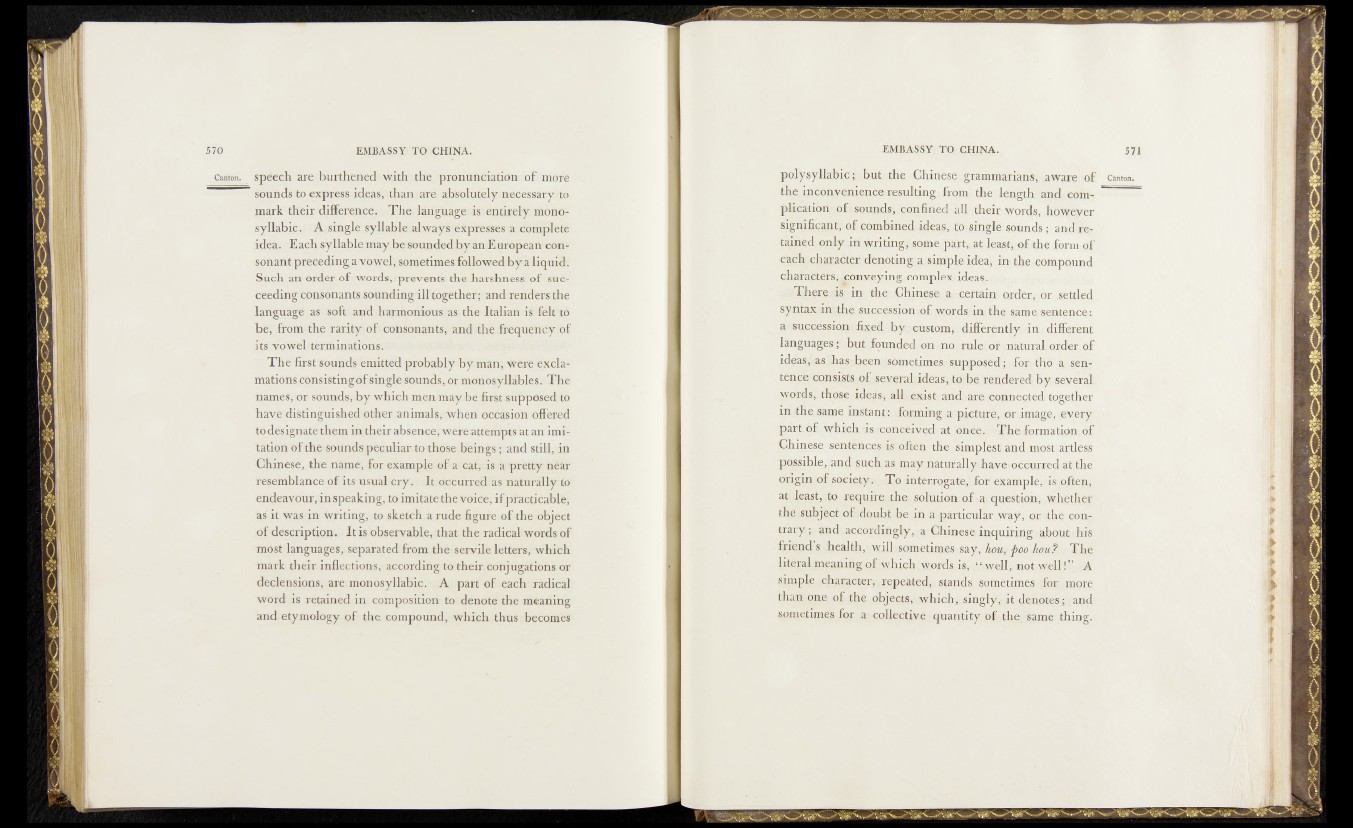
Canton'. _ spéech are bur then ed with. the pronunciatiomofmotfe
sounds-to express ideas;; than are absolutelyineGessaryrto,
mark their difference? The"
syllabic.' A;single syllable alwayss eiplresses a complete
idea . Each syllable may be sounded by an European conr
sonant preceding a vowel, sometimes followed by a liquid.
Such an order of words,*.‘prevents thecdiarshnessDof w et
eeeding consonants soundingill together; and renders the
language as soft and harmonious as: the Italian is-felt to
be,: fromvthe ratity trf' consonants, and the .frequëncysóf
its vowel terminations. ;
The-first sounds-emitted probably by man^werfe-nxcla-
mations consisting©!’single sounds, or monosyllables .• The
names, or sounds? fey which men. may be hrstisuppfised:^
have distinguished other animals, whetf occasion offered
to designate them in their absence^ were attempts at an. imitation
of the sounds peculiar to those beings p arid still, in
Chinese, th® name, for example of a -Gat, is'?a®prèÉtJpnéaï
resemblance of its usual .cry«. It occurred as naturally“#
endeavour, inspeaking, to imitatethevoice? i f practicable;
as it was in writing, to sketch.a rude figure of the bbject
of description. It is observable, that the radical words of
most languages,.separated from the servile letters, which
mark their inflections, according to. their, conjugations or
declensions, are monosyllabic. A part of each radical
word is retained in composition to. denote the meaning
and-etymology o f the. compound, which thus becomes
polysyllabic? but the Chine^grammarians,. .aware of
the in cony^ni^e^ppltiug: from the'length and, complication.
ofi*sounds, confined-ja l^the ir. words;, ho^eyer
significant,-®! combine<hid©asr,j/p|rs.ir!;gl©^ sound's; andfre-
tjjtt^d- opkyjn writing^ some/paS:%at least-,, p^thfe^fqrm qf
e^eh|>ch^yt,er, deqofep^,simple idea, in the compound
characters .^onveyingoomplexL ideas;.<,
. v.There^iF in -the Chiqtset ascertain prd.eo^ ©resettled
syntax- in.the- spee®s§iqn of .words inihhe § a<mp c , e $
* ^’fecession fixed by£ custom, differently*jin different
languages?^ butjfouuded on ,-no ruleioh^n^tural^der of
ideas?' as hasabeeniisbmetjme^ss^upposed; f<>fcir, tho -a yen-
ten^Gpnsi-stS. o^sevcsal-/ ideas; ter be ren-d^F.&d? bys^yeial
^qrds, those idea's, all exist).and/a^ercqftne.qtpd together
in the same inSta nt:- Tot ming ca- 'p ic ture;,,-qt^ijsriag6f r$?
pa.rt;qjfrlvhich is ;co©eeiyed? at 'onfe^i^he, formation of
Chinese senteno^ K ^ften tfrq .simplest; andjmj(|,s||^(^efs
'^ ^j^fe -an4'^Plch,as may naturally *haver(a.ftot'yr-p.d,aff the.
origin of societyg To iiafeprogafe/Tor example^j^often..
Require,;theij#l]3?a0ft, of .aj (Jujestionjt|yhfeth&r
the subject ofudoubt^ays in a particular way,-
trary; and accordingly^ Chinese} inquiririg^Jbputj •
friend’s .health, will»sometimes say, hpu, The
literal meaniqg qfA\iS{hiqh iy»ords is, v^welIfy<not^.ell!” ,A
simple character, $ repeatedstands ;Sqm^t-imes >fpp more
than one of the objects,- which, s i^ J y
sometimes for a collective quantity. Of ,th^&same thing.